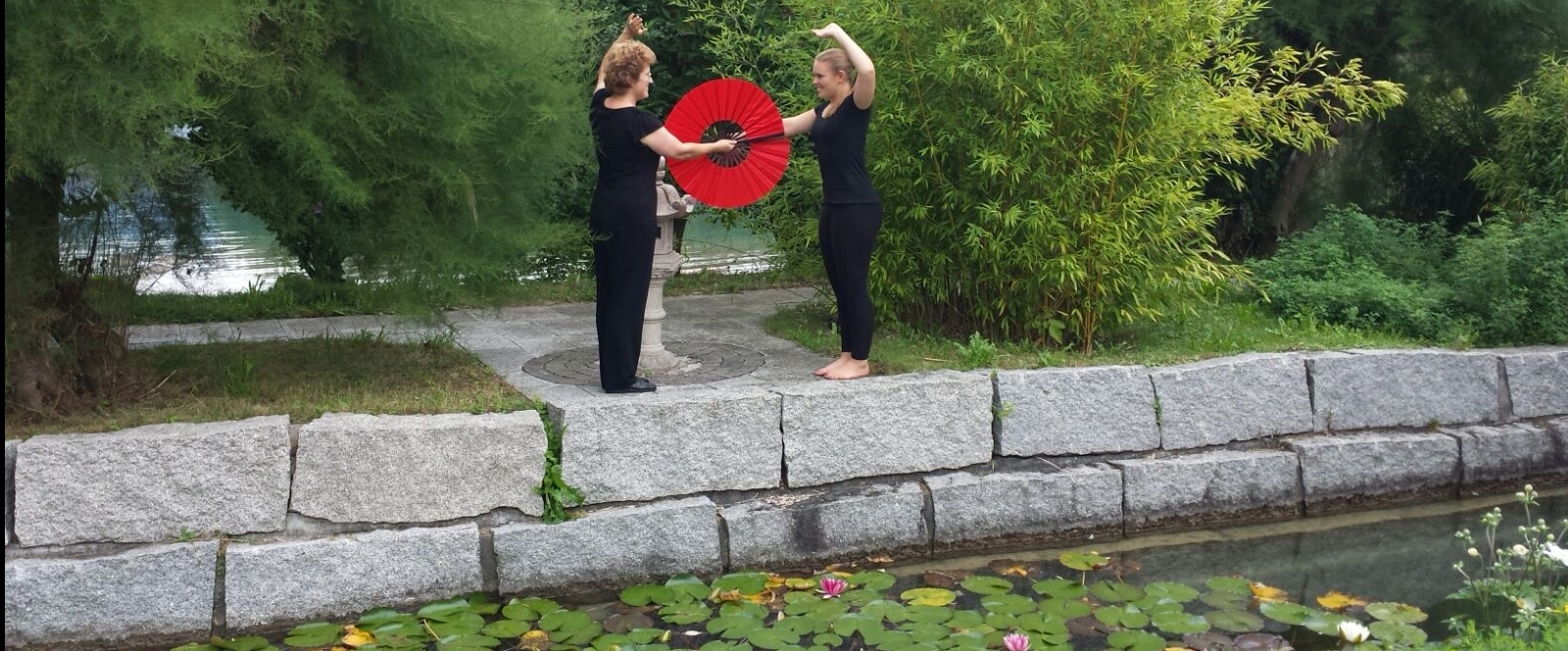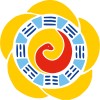
Wu Rong-huei, Chairman, Chinese Taiji Institute
At the invitation of Mrs. Huffmann and her daughter Jenny, my wife and I went to Switzerland to teach Taijiquan form, weapon, and push-hands from March 28 to April 4, 2008. That was the fourth time that our hostesses had extended their welcome to us. The two of them are Chinese culture enthusiasts with particular interest in the Book of Changes, Daodejing, and Taijiquan, which they practice regularly as the foundation of their fitness programs.Besides the warmth that our hostesses had extended to us, the scenic and hospitable landscapes, fresh air, convenient and punctual public transportation were also attractions that got us back for the fourth time. We spent most of our free time outdoors soaking up, or immersed in, Switzerland’s scenery. We were able to quickly and easily put our daily ruts in Taipei out of our minds altogether. The time that we spent with the Huffmanns also gave us a rare inside glimpse into the family life of a Swiss clan.
Mrs. Huffmann and Jenny have studied Taijiquan for more than a decade. They have a solid grasp of the stepping method, the eight postures, and the form that should be the foundation of any Taijiquan training. On a more advanced level, they also have a good handle on push-hands and Taiji weapons. The main purpose of this week-long class was to correct any errors that they and students in their studio still might have in those fundamental and advanced routines. Since they were both interested in Daoism out of which Taijiquan had grown, I also covered the philosophy of Daoism—the soft and pliable approach to Taiji training—in the class as follows.
The Taiji Classic says, “Ying doesn’t detach from yang; yang doesn’t detach from yin. When you can make yin and yang complement each other, then you have achieved the level of understanding jin.” Taijiquan is based on yin and yang. The mind leads the body’s major joints and make them light, agile, and in concert. With that, one can glue to and go with the flow of the opponent’s attack to tap into the opponent’s power, to “use four ounces to overcome a thousand pounds”. With that, one can achieve the goals of “using softness to overcome a brute force”, “overcoming movements with stillness”, “overcoming large-size with smallness”, and “overtaking quickness with slowness”.
其訓練的哲理與道德經第42章「道生一,一生二,二生三,三生萬物,萬物負陰而抱陽,沖氣以為和」有異曲同工之妙。
Push-hands training starts with relaxation, softness, yielding, and neutralization, trying to switch between fullness and emptiness, movements and stillness, hardness and softness, all at will and instantaneously. In order to be able to completely neutralize an opponent’s attack, one must completely give up one’s own will in order to yield completely to and stick with the opponent’s will and intention. This is the only path to reach the level of proficiency with which a practitioner can handle all manners of attack with seemingly magical ease.
Push-hands training starts with defense, yielding, and neutralization. This is in accord with the Classic’s “only when you can be extremely soft can you be extremely hard”. 其哲理如道德經第40章「反者,道之動,弱者道之用」與第37章「無為而無不為」doing nothing and then nothing you cannot do的哲理, Only through a reversed thought process can Taijiquan form and push-hands training reach the supreme level of complete relaxation and softness. This exactly mirrors Daoism’s “be natural and do nothing”.
This way of Taijiquan training also helps the practitioner to cultivate life’s philosophy. While practicing Taijuquan for health and spiritual harmony, one follows the graduated syllabus as prescribed by one’s master. With much practice, the inner strength and composure of the most accomplished master will gradually take root in a devoted practitioner. This occurs as naturally as when there is enough water then a canal will be formed. Because the proficiency and composure that the practitioner has mustered, the depth of his skill, or of the canal, will be beyond fathom. 如道德經第8章「上善若水,水善利萬物而不爭,處眾人之所惡,故幾於道」。
The relaxation and softness approach of Taijiquan training can help the practitioner reach the utmost level of understanding jin only when he can mirror the wisdom of the water in the canal: the wisdom of “breeding and rearing all things without taking possession of anything for itself; guiding all things down their paths without controlling them; putting itself in the worst quarters and yet achieving the most noble objectives.” Water is as real and sincere as the love of a mother; it is adept at accumulating energy, lying low and avoiding high, conspicuous places, getting in the way of nothing. It is just there quietly, conforming to whatever it happens to encounter: If it comes across a circle, it makes a circular motion. If it meets a square, it turns corner. If it comes upon a dead end, it stops. And if it meets with breach, then it flows right through or over it. (Note 2)
Water has all these characteristics of extreme softness and pliability. This trait allows water to fill any space, big or small, that it happens to be put in. It accepts whatever comes its way without expending any energy. Quite on the contrary, it keeps accumulating energy as it goes, day in and day out. Eventually, the cumulative energy reaches such enormity that nothing can withstand its onslaught.
Taijiquan push-hands training requires a practitioner to behave like water: soft, seemingly meek, conforming to its container, whatever the shape and size. First, the nine major joints of the body (ankles, knees, hips, waist, spine, neck, shoulders, elbows, and wrists) are trained to be loose and able to agilely move to conform to the opponent’s movements.
This will naturally dissipate all attacks from any opponent. The five methods of hands/arms movements are adherence, sticking,connect, following, and don’t lose/ don’t resist. One mustn’t resist the opponent in any way. The idea is to never to seek to fight back. One must have the mentality to let the opponent do whatever he wishes. Always seek to be taken advantage of and never have the slightest inclination of taking advantage of the opponent’s vulnerability. Totally abolish the idea of winning. Just go with the opponent’s movements, however they may come on. One should always be without any preconceived notion as to where one wants to go because one must always go where the opponent wants to go.
These seemingly aimless movements, at their highest level, are exactly what the Classic refers to as “mindfully feel and ponder the opponent’s movement, and, although one is following the opponent’s movement, one can gradually do as one wishes. Eventually, the table will turn as one wishes. The practitioner, who is merely following, should feel the wholeness of the energy within himself, should let this energy accumulate and evolve naturally, and then the energy will naturally find an outlet at the most opportune time. This is the ultimate achievement in Taijiquan—”follow the opponent and borrow his force”, “neutralize and attack in one movement.”
After I inculcated the above theoretical foundation of Taijiquan training to the training class in Thun, the class participants began to have a better understanding of the Daoism root of Taijiquan. They also got to know exactly what is meant by what Professor Cheng Man-ching, the teacher of my own master, had long advocated, “In Taijiquan, one doesn’t move his hands. Moving hands makes the practice un-Taijiquan”.
The participants also got to know the reason why my teacher, Master Soong Jih Jiang, advocated the training methods of “the original space position” and “the original body position” (Note 3). These methods are to train the body’s major joints to respond to the mind’s command to either relax and goes with the opponent’s motion or hold in a fixed position. The combinations between loosened joints and fixed joints according to the mind’s control can have enormous powerful applications and implications. This is just as what Daodejing says in chapter 37, “The Way does nothing and yet there is nothing that it can’t do.”
The class participants also got to see clearly that it is entirely through the relaxation of the shoulder and elbow joints that brings Ward-Off posture to Push. No muscles were engaged. This movement is accomplished from the inside (torso and waist) to the outside (the wrist and hand). This is called reversed movements.
This contrasts markedly with what many Taiji practitioners have done erroneously. They contract their muscles to move their wrist, elbow, and shoulder in order to achieve the outward appearance of Push. This is from the outside to the inside and this is wrong.
We got to spend much of our free time with the Huffmanns. My wife and I quickly got to experience all aspects of living in Switzerland. We also got to observe the education of the young in a Swiss family. Hippi, Jenny’s six-year-old son was lively, active, and energetic. I brought him into the realm of Taijiquan by way of playing games with him.
Being a kid, he tried to exert his energy on me. I lightly adhered to him which not only dissipated his explosive energy, but also allowed me to keep a close tap on his center of gravity. He had no way of landing his explosive power on me, and he had no way of ridding my sticky hands on him. Tried as he might, he simply couldn’t get rid of me. Finally, he surrendered and moved with, instead of against, my guiding hands. Soon, I noticed that he was using the principles of “borrowing power from your opponent” and “use four ounces to overcome a thousand pounds” to help him climb up trees and do summersaults. And it appeared quite easy for him to apply these Taijiquan principles. I was quite gratified.
Actually Hippi and I interacted so well that he began to show me and share with me his most treasured toys. I played with him and with his toys as he told me to. The park had a playground and toys that were designed especially for children. Generally, parents might occasionally give a hand to get the child started with a toy, but they wouldn’t interfere with what the child wanted to do. They let the child play to his or her heart’s content. I was so absorbed by the unfettered and joyful child play that I almost forgot my own existence如道德經第10章「載營魄抱一,能無離乎?專氣致柔,能如嬰兒乎?滌除玄覽,能無疵乎?」。
My wife and I would like to express our gratitude to the Hoffmanns and the class participants. We also enjoyed what we learned from the interaction with Hippi.

Teilen auf: